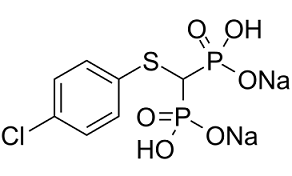This product is for research use only, not for human use. We do not sell to patients.

| Size | Price | Stock |
|---|---|---|
| 50mg | $450 | Check With Us |
| 100mg | $750 | Check With Us |
| 200mg | $2025 | Check With Us |
Cat #: V16456 CAS #: 149845-07-8 Purity ≥ 98%
Description: Tiludronate (Tiludronate disodium; Tiludronic Acid disodium) is a novel and potent bisphosphonate agent which prevents postmenopausal bone loss and is used for treatment of Paget's disease of bone (osteitis deformans) in human medicine.
References: Bonjour JP, et al. Tiludronate: bone pharmacology and safety. Bone. 1995;17(5 Suppl):473S-477S.
Publications Citing InvivoChem Products
Product Promise

- Physicochemical and Storage Information
- Protocol
- Related Biological Data
- Stock Solution Preparation
- Quality Control Documentation
| Molecular Weight (MW) | 362.57 |
|---|---|
| Molecular Formula | C7H7ClNa2O6P2S |
| CAS No. | 149845-07-8 |
| SMILES Code | O=P(O)(C(SC1=CC=C(Cl)C=C1)P([O-])(O)=O)[O-].[Na+].[Na+] |
| Synonyms | Tiludronate disodium; Tiludronic Acid disodium; Tiludronic acid; Skelid; Tildren |
| Protocol | In Vitro | The ability of Tiludronate to inhibit proton transport is 5-fold higher in kidney-derived vesicles (IC50=1.1 mM) and 10,000-fold higher in vesicles derived from osteoclasts (IC50=466 nM). Tiludronate also potently inhibits proton transport in yeast microsomal preparations (IC50=3.5 microM) and inhibits the activity of purified yeast V-ATPase. The inhibition of the osteoclast V-ATPase-mediated proton transport by Tiludronate is rapid, pH-dependent, and reversible |
|---|---|---|
| In Vivo | Tiludronate exerts a dose-dependent inhibitory activity on bone resorption. Tiludronate could act on mature osteoclasts by reducing their capacity to secrete proton into the resorption space and also by favoring their detachment from the bone matrix. Tiludronate is also tested in other models of osteoporosis. In the castrated male rat model, Tiludronate (5-200 mg/kg; p.o.) prevents the decrease in the skeletal mass, assessed physically by measuring the bone weight and density or chemically by determining the calcium and phosphate content |
| Solvent volume to be added | Mass (the weight of a compound) | |||
|---|---|---|---|---|
| Mother liquor concentration | 1mg | 5mg | 10mg | 20mg |
| 1mM | 2.7581 mL | 13.7904 mL | 27.5809 mL | 55.1618 mL |
| 5mM | 0.5516 mL | 2.7581 mL | 5.5162 mL | 11.0324 mL |
| 10mM | 0.2758 mL | 1.3790 mL | 2.7581 mL | 5.5162 mL |
| 20mM | 0.1379 mL | 0.6895 mL | 1.3790 mL | 2.7581 mL |
This equation is commonly abbreviated as: C1 V1 = C2 V2
- (1) Please be sure that the solution is clear before the addition of next solvent. Dissolution methods like vortex, ultrasound or warming and heat may be used to aid dissolving.
- (2) Be sure to add the solvent(s) in order.




































